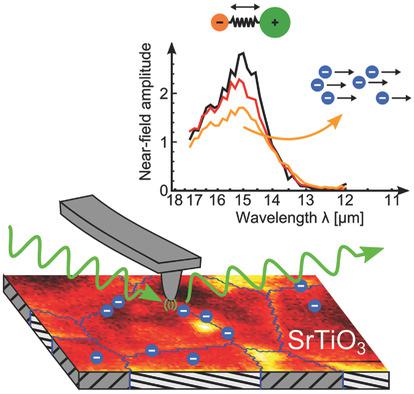当前位置:
X-MOL 学术
›
Adv. Funct. Mater.
›
论文详情
Our official English website, www.x-mol.net, welcomes your feedback! (Note: you will need to create a separate account there.)
Nanospectroscopy of Infrared Phonon Resonance Enables Local Quantification of Electronic Properties in Doped SrTiO3 Ceramics
Advanced Functional Materials ( IF 19.0 ) Pub Date : 2018-09-05 , DOI: 10.1002/adfm.201802834 Martin Lewin 1 , Christoph Baeumer 2 , Felix Gunkel 3 , Alexander Schwedt 4 , Fabian Gaussmann 5 , Jochen Wueppen 5 , Paul Meuffels 2 , Bernd Jungbluth 5 , Joachim Mayer 4 , Regina Dittmann 2 , Rainer Waser 3 , Thomas Taubner 1
Advanced Functional Materials ( IF 19.0 ) Pub Date : 2018-09-05 , DOI: 10.1002/adfm.201802834 Martin Lewin 1 , Christoph Baeumer 2 , Felix Gunkel 3 , Alexander Schwedt 4 , Fabian Gaussmann 5 , Jochen Wueppen 5 , Paul Meuffels 2 , Bernd Jungbluth 5 , Joachim Mayer 4 , Regina Dittmann 2 , Rainer Waser 3 , Thomas Taubner 1
Affiliation

|
Among the novel materials for electronic applications and novel device concepts beyond classical Si‐based CMOS technology, SrTiO3 represents a prototype role model for functional oxide materials: It enables resistive switching, but can also form a 2D electron gas at its interface and thus enables tunable transistors. However, the interplay between charge carriers and defects in SrTiO3 is still under debate. Infrared spectroscopy offers the possibility to characterize structural and electronic properties of SrTiO3 in operando, but is hampered by the diffraction‐limited resolution. To overcome this limitation and obtain nanoscale IR spectra of donor‐doped Sr1‐xLaxTiO3 ceramics, scattering‐type scanning near‐field optical microscopy is applied. By exploiting plasmon–phonon coupling, the local electronic properties of doped SrTiO3 are quantified from a detailed spectroscopic analysis in the spectral range of the near‐field ‘phonon resonance’. Single crystal‐like mobility, an increase in charge carrier density N and an increase in ε∞ at grain boundaries (µ≈ 5.7 cm2 V−1s−1, N = 7.1 × 1019 cm−3, and ε∞ = 7.7) and local defects (µ≈ 5.4 cm2 V−1s−1, N = 1.3 × 1020 cm−3, and ε∞ = 8.8) are found. In future, subsurface quantification of defects and free charge carriers at interfaces and filaments in SrTiO3 can be envisioned.
中文翻译:

红外声子共振的纳米光谱技术能够对SrTiO3掺杂陶瓷的电子性能进行局部量化
在电子应用的新型材料和经典的基于Si的CMOS技术之外的新型器件概念中,SrTiO 3代表了功能性氧化物材料的原型角色模型:它可以进行电阻切换,但也可以在其界面处形成二维电子气,从而实现可调晶体管。然而,电荷载体与SrTiO 3中的缺陷之间的相互作用仍在争论中。红外光谱法可用于表征SrTiO 3的结构和电子性质,但受衍射极限分辨率的影响。为了克服此限制并获得施主掺杂的Sr 1-x La x TiO 3的纳米级红外光谱陶瓷,应用散射型扫描近场光学显微镜。通过利用等离振子-声子耦合,可以在近场“声子共振”的光谱范围内通过详细的光谱分析对掺杂的SrTiO 3的局部电子性质进行量化。单晶样的流动性,增加载流子密度Ñ和增加ε ∞在晶界(μ听,说: 5.7厘米2 V -1小号-1,Ñ = 7.1×10 19厘米-3,和ε ∞ = 7.7 )和局部缺陷(μ听,说: 5.4厘米2 V -1小号-1,Ñ = 1.3×10 20厘米-3,和ε ∞ = 8.8)中找到。将来,可以设想SrTiO 3中界面和细丝处的缺陷和自由电荷载子的地下定量。
更新日期:2018-09-05
中文翻译:

红外声子共振的纳米光谱技术能够对SrTiO3掺杂陶瓷的电子性能进行局部量化
在电子应用的新型材料和经典的基于Si的CMOS技术之外的新型器件概念中,SrTiO 3代表了功能性氧化物材料的原型角色模型:它可以进行电阻切换,但也可以在其界面处形成二维电子气,从而实现可调晶体管。然而,电荷载体与SrTiO 3中的缺陷之间的相互作用仍在争论中。红外光谱法可用于表征SrTiO 3的结构和电子性质,但受衍射极限分辨率的影响。为了克服此限制并获得施主掺杂的Sr 1-x La x TiO 3的纳米级红外光谱陶瓷,应用散射型扫描近场光学显微镜。通过利用等离振子-声子耦合,可以在近场“声子共振”的光谱范围内通过详细的光谱分析对掺杂的SrTiO 3的局部电子性质进行量化。单晶样的流动性,增加载流子密度Ñ和增加ε ∞在晶界(μ听,说: 5.7厘米2 V -1小号-1,Ñ = 7.1×10 19厘米-3,和ε ∞ = 7.7 )和局部缺陷(μ听,说: 5.4厘米2 V -1小号-1,Ñ = 1.3×10 20厘米-3,和ε ∞ = 8.8)中找到。将来,可以设想SrTiO 3中界面和细丝处的缺陷和自由电荷载子的地下定量。



























 京公网安备 11010802027423号
京公网安备 11010802027423号